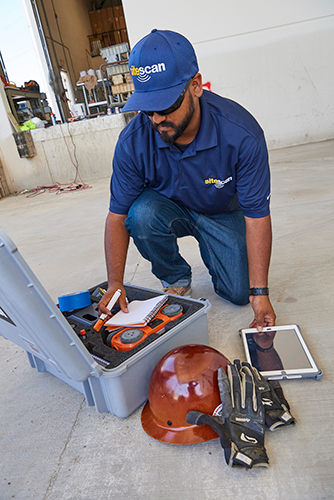RainierGPR Concrete Scanning: Advanced Solutions for Safe Building And Construction
RainierGPR Concrete Scanning: Advanced Solutions for Safe Building And Construction
Blog Article
Checking Out the Key Advantages of Concrete Scanning in Building Projects
In the realm of modern building techniques, the usage of concrete scanning innovation has emerged as a critical tool for making sure job effectiveness and architectural honesty. From improving precaution to accurately spotting utilities hidden underneath the surface, the benefits of concrete scanning are diverse. The ability to enhance task timelines and reduce costs while protecting existing frameworks is a testament to the worth this innovation brings to the building market. As we look into the nuanced benefits of concrete scanning, it becomes apparent that its effect expands far past surface-level analyses, offering a peek into the intricate web of advantages waiting to be discovered.
Improved Precaution
Making use of sophisticated concrete scanning modern technology boosts precaution on construction websites by providing exact discovery of possible threats hidden under the surface area. This modern technology makes it possible for building and construction groups to determine rebar, conduits, post-tension wires, and other obstructions before excavation or drilling, considerably minimizing the threat of crashes. By identifying these aspects specifically, employees can prevent harmful important structural parts, hence stopping injuries, hold-ups, and pricey repair work.
Additionally, concrete scanning plays a vital duty in making certain the stability of existing structures during growths or renovations. By discovering weaknesses, spaces, or damage within concrete components, engineers can attend to these issues proactively, boosting the overall security and longevity of the structure. This positive strategy not just minimizes the danger of architectural failures however also lessens the potential for accidents triggered by unforeseen structural shortages.
In essence, the execution of concrete scanning technology acts as an aggressive precaution that safeguards both construction employees and the structural stability of buildings, eventually adding to the total success and efficiency of building tasks. - RainierGPR Concrete Scanning
Accurate Discovery of Energies
Concrete scanning technology facilitates specific recognition of underground utilities, boosting building and construction site safety and security and performance. Precise detection of utilities is important in construction jobs to avoid pricey damages, job hold-ups, and most notably, make sure the security of workers and the public. By utilizing advanced scanning technologies such as ground-penetrating radar (GPR) and electromagnetic induction, construction teams can draw up the place of hidden pipes, cable televisions, and other energies with high levels of precision.

Time and Expense Effectiveness

Concrete scanning modern technology allows construction groups to precisely find rebar, post-tension cords, and other embedded items within concrete structures. This specific details aids in preventing costly errors such as unintended damage to essential elements during boring, cutting, or coring activities. In addition, by identifying possible risks in advance, the demand for pricey repairs or revamp because of problems can be minimized, resulting in cost savings for the project.

Additionally, the capacity to quickly and accurately detect energies below the surface without causing any type of damage not only conserves time yet also prevents pricey disruptions to existing framework. On the whole, the time and cost efficiency benefits of concrete scanning make it an important device for improving construction task administration and implementation.
Conservation of Structural Stability
Protecting the structural stability of buildings and framework is critical in ensuring long-term stability and security. Concrete scanning plays a vital role in this preservation procedure by allowing construction specialists to identify possible threats to the structural stability of a building or framework before they intensify right into major issues. Via the usage of sophisticated scanning technologies such as ground-penetrating radar (GPR) and electro-magnetic induction, building and construction teams can non-invasively examine the problem of concrete frameworks, locate rebar, post-tension cable televisions, and other ingrained components, and recognize any type of gaps, fractures, or deterioration great site within the concrete.
Improved Project Preparation
In order to make sure the successful execution of building and construction projects, thorough focus to detail and detailed planning are necessary components that stem from an extensive understanding of the architectural problems determined with concrete scanning. Ultimately, incorporating concrete scanning right into the project planning phase improves coordination among team members, cultivates proactive analytical, and contributes to the successful delivery of building tasks within spending plan and schedule restrictions.
Verdict
To conclude, concrete scanning offers countless benefits in building and construction projects. By improving safety measures, accurately discovering energies, enhancing time check that and expense effectiveness, maintaining structural stability, and aiding in job preparation, concrete scanning proves to be a necessary tool for successful task execution. Its ability to minimize threats, enhance efficiency, and ensure task honesty makes it an important property for building and construction professionals.
In the world of contemporary building and construction techniques, the application of concrete scanning technology has emerged as a critical tool for making certain task effectiveness and structural stability.Concrete scanning technology allows building teams to precisely locate rebar, post-tension cable televisions, and various other ingrained objects within concrete frameworks. With the use of innovative scanning innovations such as ground-penetrating radar (GPR) and electro-magnetic induction, building groups can non-invasively evaluate the condition of concrete structures, situate rebar, post-tension cable televisions, and various other ingrained aspects, and determine any kind of spaces, fractures, or degeneration within the concrete.
In order to make certain the effective execution of building and construction jobs, thorough focus to detail and thorough preparation are vital components that stem from a comprehensive understanding of the architectural conditions identified via concrete scanning. Inevitably, integrating concrete scanning into the job preparation stage improves sychronisation among team participants, promotes proactive problem-solving, and adds to the successful distribution of building and construction jobs within budget and schedule restraints.
Report this page